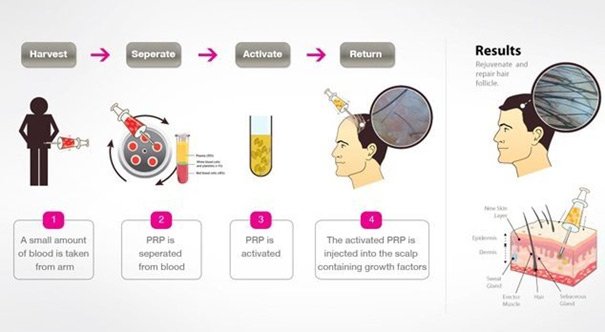
PRP or platelet-rich plasma therapy is a treatment method that is applied in the form of injection of the blood taken from the person himself to the tissues planned to be treated in the body after undergoing various processes. It can be used for aesthetic problems such as hair loss and skin rejuvenation, as well as to accelerate the healing of injured tendons, ligaments, muscles and joints.
WHAT IS PRP?
PRP means platelet rich plasma, that is, blood rich in clot cells. In the treatment of PRP, plasma obtained from the person’s own blood, rich in clot cells and growth factors, is used to regenerate the skin.
What can PRP treatment do?
- It is regenerative / restructuring,
- It supports not only the formation of basic matrix elements such as new collagen hyaluronic acid in the subcutaneous tissue, but also all vital functions of the skin.
- It provides removal of wrinkles and lines by “rejuvenating” the skin, not “filling” it.
- The bright and healthy appearance that appears after the first application may show a slight regression after a while, for this it is necessary to make several consecutive applications and to ensure the continuation of the rejuvenating effect.
- When the cures consisting of 3 applications on average are repeated once every 6-12 months, a long-acting rejuvenating effect that can be considered permanent will be achieved.
Usage areas
PRP application is only one of the application areas of cellular therapy.
In general, in aesthetic medicine, PRP is used in body parts such as face, neck, décolleté, hands, inner thighs, arms;
Providing rapid structuring of the skin immediately after applications such as laser / peeling,
To restore wrinkles, remove depressions, regain elasticity and brightness, reversing the results of years and exposure to UV rays on the skin,
To ensure the control of wounds, cracks and situations where the quality of the skin is damaged, which takes a long time to heal,
To use alone in hair loss or to strengthen the effect of other treatment options,
We see that it is applied in many areas other than the above-mentioned areas.
The second area in which PRP is widely used is orthopedics and reconstructive surgery.
Application process
2 or 5 tubes (16-50 ml) of blood are taken from the person to whom the application will be made, and platelets (thrombocytes) are separated in the centrifuge device. Thus, platelets condense and accumulate in the tube in the kit, and a blood product called PRP emerges. This product can be applied subcutaneously, intramuscularly or intraarticularly. Depending on the nature of the product used for an effective result, 4-6 doses are recommended for a course, either every day or 2 times a week.
Depending on the application area, the application process may take from 1-2 minutes to 30 minutes.
How does PRP regenerate the skin?
When the skin is injured, clot cells come in to repair the skin. Clot cells start the process of repairing the skin by secreting substances called growth factors. They also attract stem cells to the injured area. Therefore, when the skin is treated with PRP rich in clot cells, the repair and regeneration process of the skin is triggered.
How is PRP obtained?
In PRP treatment, 8-20 cc of blood is taken and placed in special tubes. The amount of blood taken varies according to the characteristics of the tube. Special tubes are placed in the centrifuge device rotating at high speed. The centrifuge device must rotate at a certain speed and time in order to obtain rich plasma from the clot cells. In the plasma obtained without special tubes, the clot cells remain around 200 thousand. This number is not enough to renew the skin. In PRP treatment, plasma containing one million clot cells can be obtained by means of special tubes in which blood is placed.

How is PRP effective?
When a part of our skin is injured, clot cells first come to this area in order to repair the tissue. The clot cells coming to the area secrete growth factors, attract the stem cells to this area and initiate the repair of the tissue. In the PRP method, plasma rich in clot cells and growth factors triggers the repair of the skin and renews the skin.
What are the benefits of PRP?
PRP treatment is a new method used in skin sagging, wrinkles, blemishes, acne scars, scars, skin cracks and hair loss.
Applying the PRP method alone or in combination with laser, radiofrequency and light therapy methods makes the skin much better. Decrease in sagging, lightening of wrinkles, lightness and clarity occur on the face. Adding PRP to stain treatments such as laser and peeling accelerates the treatment of stains and supports permanent results.
Who can PRP be applied to?
PRP is used alone or in combination with other skin rejuvenating methods in sagging, wrinkles, scars, acne scars and hair treatments that require skin regeneration.
How is PRP treatment done?
In the obtained plasmas, the part at the bottom of the tube is the richest part of clot cells and growth factors. The part at the bottom of the plasma should especially be used. The plasma obtained in the PRP treatment is given under and inside the skin with the help of tiny needles in the problematic area of the skin. After fractional laser, fractional radiofrequency and microneedling applications, PRP serum can be applied to the skin. PRP is easily absorbed by the skin through the opened pores.
How often should PRP be done?
PRP treatment is done at intervals of 2-4 weeks. PRP should be done in 3-4 sessions. PRP can be applied again after 6-12 months.
Who is PRP not applied to?
It is not applied to those who take blood thinners, those with a history of cancer, those with blood diseases, those with infection and inflammation in the area to be treated, and those who are pregnant and breastfeeding.
How long does the PRP application take?
Preparation of PRP after blood collection takes approximately 8-15 minutes. takes. Application of PRP to the skin takes 10-20 minutes. between.
Is pain felt in PRP application?
Before the procedure, the skin is numbed by applying anesthetic cream. PRP is applied using tiny needles. That’s why you don’t feel too much pain.
When are the results of PRP treatment visible?
PRP treatment is based on the principle of self-renewal of the skin. Therefore, treatment results are seen late. The results of PRP treatment appear after the second or third session.
After PRP treatment, there is a decrease in skin tightening and sagging due to skin regeneration, reduction in wrinkles, lightening of spots on the skin, brightness in skin color and reduction in scars. After the applications to the scalp, an increase in hair thickness and condensation in rare areas are observed.
How long is the effect of PRP treatment?
PRP skin correction effects occur in 3-6 months. Its effects on the skin continue for about 1-1.5 years.
Can PRP be used with other skin rejuvenation methods?
PRP can be applied together with methods such as laser, radiofrequency, light treatments, mesotherapy and micro needling. After such procedures, in the form of serum, the effectiveness of other methods is increased and recovery times can be shortened.

